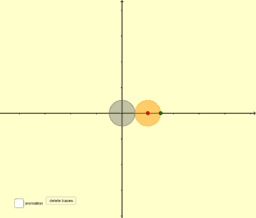Outline
On Rotating and Rolling
This is a series of applets drawn from the website mathMINDhabits [sites.google.com/site/mathmindhabits]
that is designed for teachers of mathematics who want to deepen their understanding of the mathematics they teach
and that their students are expected to learn.
The applets in this collection all focus on circular and/or rotational motion in different settings.
In the first chapter the first two applets deal with a circle rolling around either the outside or the inside of a second circle.
Many people find the phenomenon puzzling. The search for a resolution of the puzzle provides a
good deal of insight into the nature of rotational motion.
The next two applets deal with a rolling wheel with a pebble stuck on the outer rim of the wheel. The trajectory of the pebble is then
displayed both in space and in time. The "Pebble stuck in a Wheel" applet displays the height of the pebble as a function of distance
along the road and as a function of time. The Pebble stuck in a Wheel - revisited" displays these same trajectories in a single
three dimensional [distance, height, time] space.
The final applet in the first chapter, "Rolling Disk Illusion", clarifies the need to be clear about the nature of the points being followed
in describing rotational motion.
The second chapter applets "two lap average" and "two lap average - revisited" both explore the question of how average speed varies
as a driver traverses a closed course during two successive laps. "A Run for Two" lets the user consider how the separation between
two runners varies as a function of time as they run around a circular track, either in the same or in opposite directions.
The applets in the third chapter deal with planetary motion. In "Two Planets & A Sun - A Digital Triptych" the motions of a sun and two of its planets are seen in each of their coordinate systems. Retrograde motion of planets becomes more readily understandable in such displays. The applet "Planetary Orbits in Two Frames" displays the motion of a sun-planet system as seen in the frame of the center-of-mass of the two bodies as well as the motion as seen from a vantage point in which the center-of-mass moves with constant velocity.
The applets in the fourth chapter all deal with motion in a spiral. The first applet, "How a DVD Player Works" explores the motion of the rotating disk and the way the information on the disk is recorded and played back. The next two applets, "A Road Up A Mountain" and "Another Road Up A Mountain", both deal with the problem of possible paths of fixed slope up a mountain - in the first case the mountain is shaped like a cone, in the second case like an inverted parabolic bowl. A final applet in this chapter displays a zoo of classic spirals.
The final chapter shows a classic paradox called "Aristotle's Wheel".
